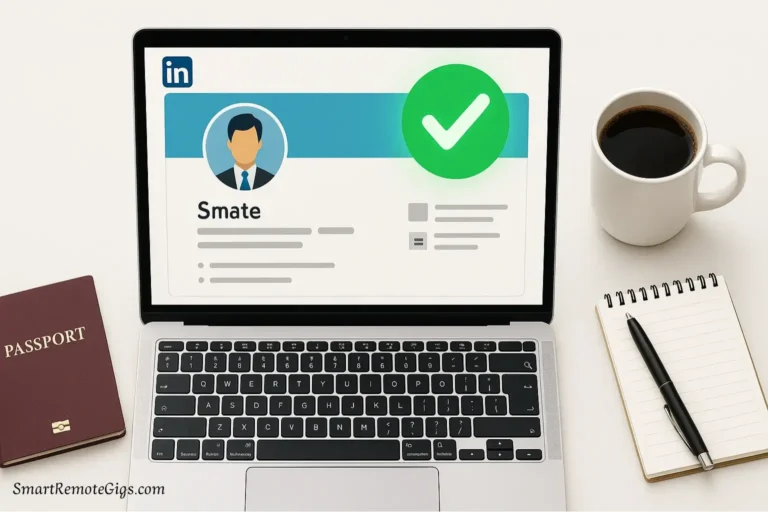Staring at the same four office walls, dreaming of a laptop on a beach in Bali or a café in Barcelona? You’re not alone. The digital nomad dream has exploded, but let’s be honest: the internet is a chaotic mess of conflicting advice and glamour shots that don’t match reality.
That’s why we built this guide. We were tired of the fragmented tips and outdated information. We wanted to create the one resource we wish we’d had: a complete operating system to transform you from office-bound dreamer to location-independent professional. This is your single source of truth—a clear roadmap through every phase of your journey, from the initial reality check to thriving in your first 90 days abroad.
A Word from Our Team: “The hardest part isn’t booking the flight; it’s the mental and logistical prep work you do before you leave. Nail that, and you’re 90% of the way to a successful nomad life. This guide is your prep checklist.” – Michael, 6-year nomad & Co-founder
Phase 1: The Reality Check – Is This Dream for You?

What is a Digital Nomad? The Real Definition
A digital nomad is a professional who leverages technology to work remotely while maintaining a location-independent lifestyle. But let’s shatter some myths right away: being a digital nomad isn’t a permanent vacation, it’s not always Instagram-worthy, and it’s definitely not an escape from work responsibilities.
Successful digital nomads are often more disciplined and organized than their office-bound counterparts. They navigate time zones, unreliable internet, visa restrictions, and the constant challenge of staying productive while exploring new places.
What digital nomadism actually means:
- Working full-time while traveling or living in different locations
- Managing your own logistics, from accommodation to healthcare
- Adapting to different cultures, languages, and business practices
- Building location-independent income streams
- Maintaining work-life balance without traditional boundaries
This lifestyle requires professional skills, personal resilience, and logistical savvy. It’s less about escaping responsibility and more about redesigning how and where you fulfill those responsibilities.
The Nomad Litmus Test: An Honest Self-Assessment
Before diving into the how-to process, honestly assess whether this lifestyle fits your personality and goals. Answer these ten critical questions:
Do you thrive in uncertainty or need predictable routines? The nomad life is full of unexpected challenges and constant adaptation.
Can you work independently without direct supervision? Remote work requires exceptional self-discipline and time management.
Are you comfortable being alone for extended periods? Loneliness is one of the biggest challenges nomads face.
Do you have strong problem-solving skills? You’ll navigate everything from visa issues to internet outages independently.
Are you willing to sacrifice material comforts for experiences? Living out of a suitcase means letting go of many possessions.
Can you handle financial uncertainty? Income can be irregular, especially when starting out.
Do you enjoy learning about new cultures and languages? Cultural adaptation is essential for long-term success.
Are you physically and mentally healthy enough to handle travel stress? Constant movement can be demanding.
Do you have emergency funds for unexpected situations? Medical emergencies and visa issues require financial cushions.
Can you maintain professional relationships remotely? Building business relationships requires extra effort when you’re not physically present.
If you answered “no” to more than three questions, consider developing these skills before making the leap. The digital nomad journey isn’t a race—preparation beats rushing.
The Business Case: Pros vs. Cons (with Data)
Let’s examine the nomad life with real data and honest insights. While studies show 87% of nomads report higher job satisfaction, it’s crucial to understand both sides of the coin.
The Reality Breakdown:
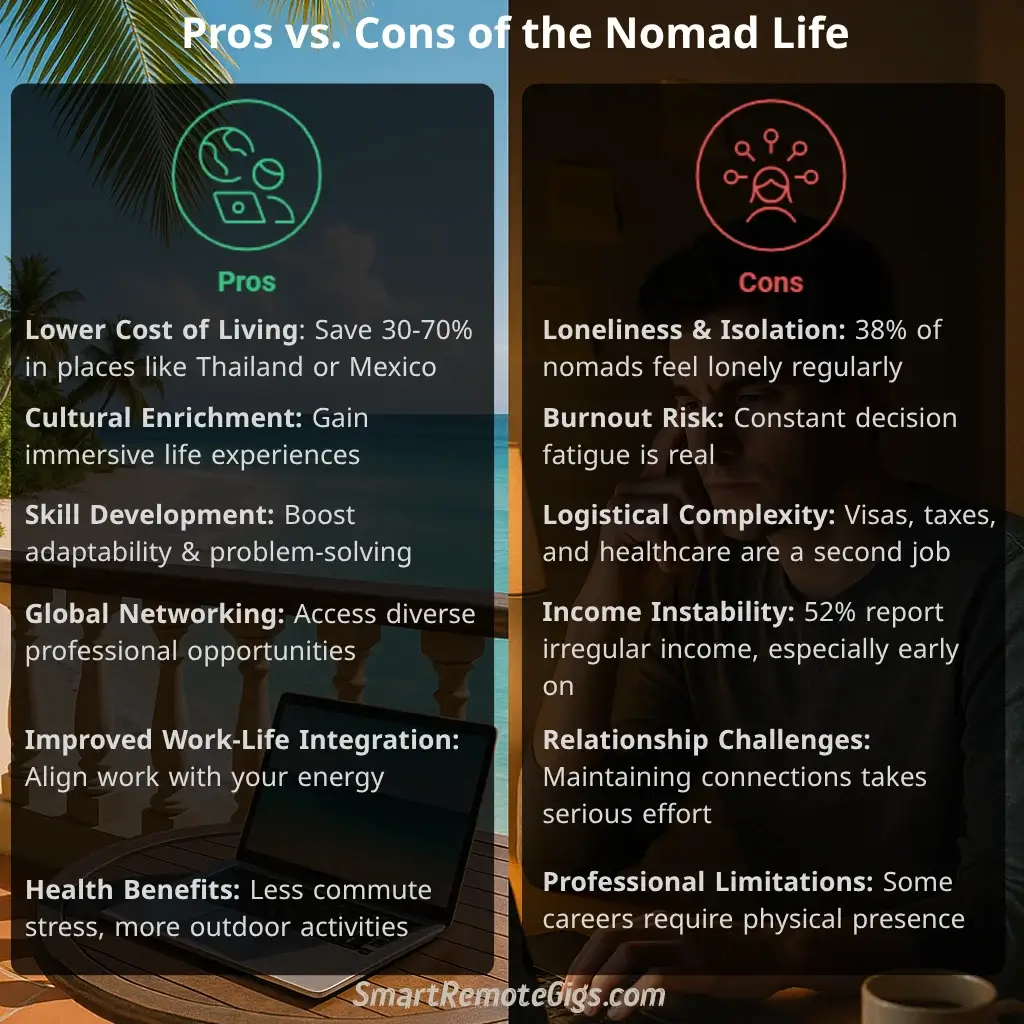
According to Buffer’s 2024 State of Remote Work report, remote workers save $4,000 annually on commuting alone, while nomads in lower-cost destinations stretch dollars even further. However, 27% struggle with unplugging after work—a challenge that’s amplified when your office is also your living space and vacation destination.
The key is understanding that nomadism amplifies both benefits and challenges of remote work. Success depends on maximizing advantages while building systems to handle the drawbacks.
Phase 2: The Blueprint – Building Your Escape Plan
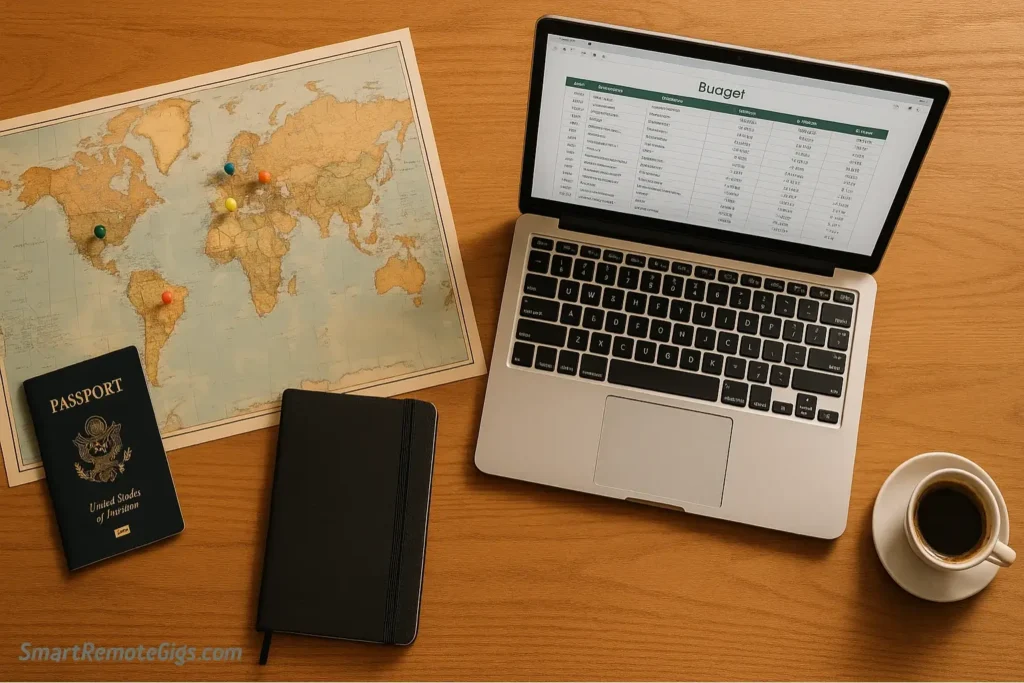
Step 1: Secure Your Income Stream
Your income strategy is the foundation of your nomadic journey. Without reliable revenue, even exotic destinations become stressful rather than inspiring. Here are three primary paths:
Option A: The Remote Employee
The employee route offers the most stability, making it ideal for beginners. You’ll have predictable income, often with benefits, plus established company structure.
Best remote-friendly industries:
- Technology (development, cybersecurity, data analysis)
- Marketing (content, social media, digital advertising)
- Customer service and support
- Finance and accounting
- Education and training
- Project management
Strategies for landing remote positions:
- Target companies with remote-first cultures
- Highlight self-management and communication skills
- Demonstrate previous remote experience
- Consider transitioning your current role before leaving
- Use specialized job boards like FlexJobs and Remote.co
Pro tip: Many companies are more open to remote work for proven employees. Propose a trial period before making a complete transition.
Option B: The Freelancer
Freelancing offers maximum flexibility but requires strong business skills and financial discipline. You’ll trade security for autonomy, with potential for higher rates but irregular income.
High-demand freelance skills:
- Web development and programming
- Graphic design and UX design
- Content writing and copywriting
- Digital marketing and SEO
- Video editing and motion graphics
- Translation and virtual assistance
- Online tutoring and consulting
Client acquisition strategies:
- Build a strong portfolio
- Leverage existing network contacts
- Use platforms like Upwork and Fiverr for initial ratings
- Develop niche expertise for premium rates
- Create valuable content to attract leads
For a comprehensive breakdown of the most lucrative nomad careers, check out our detailed guide: 15 Best Digital Nomad Jobs for 2025 (With Salary Data).
Option C: The Entrepreneur
Entrepreneurship offers the highest potential returns but also the greatest risk. You’ll need startup capital, business skills, and the ability to manage everything remotely.
Nomad-friendly business models:
- E-commerce and dropshipping
- Software as a Service (SaaS)
- Online courses and digital products
- Affiliate marketing and content monetization
- Consulting and coaching services
- Digital agencies
Key considerations:
- Legal structure across different countries
- Time zone management for teams
- Building systems that don’t require constant presence
- Developing multiple revenue streams
Step 2: The Financial Runway – Your Freedom Number
Financial preparation determines whether dreams take flight or crash. Your “freedom number” is the money you need before starting your nomadic journey.
Your Freedom Number = (Monthly Expenses × 6 Months) + $2,000 Startup Fund
Real examples:
Budget nomad (Southeast Asia/Eastern Europe):
- Monthly expenses: $1,500
- Six-month cushion: $9,000
- Startup fund: $2,000
- Total: $11,000
Mid-range nomad (Portugal, Mexico, Costa Rica):
- Monthly expenses: $2,500
- Six-month cushion: $15,000
- Startup fund: $2,000
- Total: $17,000
Luxury nomad (Western Europe, Australia, Japan):
- Monthly expenses: $4,000
- Six-month cushion: $24,000
- Startup fund: $2,000
- Total: $26,000
Your startup fund covers:
- Initial flights and visa fees
- First month’s accommodation deposits
- Essential gear and equipment
- Emergency medical expenses
- Unexpected travel costs
Monthly budget categories:
- Accommodation (30-40% of budget)
- Food and dining (20-30%)
- Transportation (10-15%)
- Work expenses (coworking, internet, software)
- Entertainment and activities
- Health insurance and medical costs
- Visa and travel fees
For accurate cost-of-living data across different destinations, reference Numbeo’s comprehensive database to validate your budget calculations.
Building your runway:
- Live below your means for 6-12 months
- Take on freelance projects for additional income
- Sell unnecessary possessions
- Consider house-sitting to eliminate rent
- Automate savings to reach your number faster
Step 3: The Legal Trinity: Visas, Taxes & Insurance
Understanding legal basics saves you from costly mistakes and stressful situations abroad.
Digital Nomad Visas vs. Tourist Visas
Many countries now offer specific nomad visa programs with longer stays and work permissions.
| Country | Visa Type | Duration | Income Requirement | Key Benefits |
|---|---|---|---|---|
| Portugal | D7 Visa | 1 year (renewable) | €635/month | Path to residency, EU access |
| Estonia | Digital Nomad Visa | 1 year | €3,500/month | EU base, digital infrastructure |
| Barbados | Welcome Stamp | 1 year | $50,000/year | No income tax, Caribbean lifestyle |
| Dubai | Virtual Working Programme | 1 year | $5,000/month | No income tax, business hub |
| Mexico | Temporary Resident Visa | 1-4 years | $1,620/month | Low cost, proximity to US |
For detailed comparisons of European nomad programs, see our comprehensive analysis: Digital Nomad Visas: A Deep Dive into Portugal vs. Spain.
Important considerations:
- Nomad visas often require employment proof
- Some have tax implications
- Processing takes 2 weeks to 3 months
- Most require comprehensive health insurance
For official application requirements, visit the Portuguese SEF immigration portal for the most up-to-date D7 visa information.
Tax Basics
Tax obligations vary based on citizenship, residence, income sources, and time spent in different countries.
Key concepts:
- Tax residency vs. citizenship (usually 183+ days determines residency)
- US citizens must file regardless of residence
- Tax treaties prevent double taxation
- Some countries offer favorable “tax nomad” programs
Critical advice: Tax laws are complex and penalties severe. Always consult an international tax professional before major decisions.
Insurance Essentials
Comprehensive coverage is non-negotiable. Medical emergencies abroad can cost $100,000+.
Essential coverage:
- Travel health insurance: Medical emergencies and routine care
- Equipment insurance: Laptop, camera, work gear protection
- Trip interruption: Reimburses non-refundable expenses
- Professional liability: For freelancers and consultants
- Personal liability: Legal issues and accidents
Recommended providers:
- SafetyWing: Designed for nomads, flexible terms
- World Nomads: Comprehensive with adventure coverage
- IMG Global: High-end international health insurance
- Cigna Global: Premium with extensive networks
Phase 3: The Launch Sequence – Your First 90 Days

Step 4: Choose Your First Destination (Data-Driven)
Your first destination sets the tone for your entire journey. Choose wisely, and you’ll build confidence for years. Here’s a data-driven comparison of five beginner-friendly hubs.
| Destination | Monthly Cost | Internet Speed | Safety | Community | Best For |
|---|---|---|---|---|---|
| Lisbon, Portugal | $1,800-2,500 | 58.4 Mbps | 8.3/10 | Very Strong | EU access, work-life balance |
| Chiang Mai, Thailand | $800-1,200 | 24.1 Mbps | 7.1/10 | Excellent | Low cost, SEA gateway |
| Mexico City, Mexico | $1,200-1,800 | 31.8 Mbps | 6.2/10 | Strong | Culture, US time zones |
| Medellín, Colombia | $900-1,400 | 27.3 Mbps | 6.8/10 | Growing | Climate, low cost |
| Canggu, Bali | $1,000-1,500 | 19.7 Mbps | 7.5/10 | Very Strong | Wellness, beach lifestyle |
Detailed breakdown:
Lisbon, Portugal
- Pros: EU residence pathway, excellent healthcare, reliable infrastructure
- Cons: Higher costs, bureaucratic processes
- Perfect for: First-time nomads wanting European sophistication
Chiang Mai, Thailand
- Pros: Extremely low costs, excellent food, established nomad infrastructure
- Cons: Air pollution, distance from Western time zones
- Perfect for: Budget-conscious nomads, Southeast Asia enthusiasts
Mexico City, Mexico
- Pros: Rich culture, excellent food, US time zone alignment
- Cons: Air pollution, altitude adjustment, safety concerns in some areas
- Perfect for: Cultural enthusiasts, Spanish learners
Medellín, Colombia
- Pros: Perfect weather, low costs, friendly locals, growing tech scene
- Cons: Limited international flights, developing infrastructure
- Perfect for: Adventure seekers, Spanish speakers
Canggu, Bali
- Pros: Beach lifestyle, wellness community, beautiful nature
- Cons: Traffic congestion, monsoon season, tourist crowds
- Perfect for: Wellness-focused nomads, surfers
Pro Tip: “Your first week in a new city should have zero work deadlines. Dedicate it to logistics (SIM card, groceries, exploring your neighborhood) and exploration. I learned this the hard way after trying to manage client calls while hunting for apartments in Bangkok.”
– Sarah Chen, 4-year nomad and UX consultant
Choosing framework:
- Stay within 1-2 time zones of important clients
- Choose destinations with easy visa policies
- Rank priorities: cost, community, weather, culture
- Research climate patterns and seasons
- Consider a 1-2 month trial before longer commitments
Step 5: Downsize Your Life: A Practical Checklist
Transitioning to nomadism requires ruthless downsizing and systematic organization. This process is both practical and psychological—reshaping your relationship with material things.
6-8 weeks before departure:
- □ Inventory everything you own by room and category
- □ Categorize: Keep, Store, Sell, Donate, Discard
- □ Research storage options
- □ Begin selling valuable items on eBay, Facebook Marketplace
- □ Digitize important documents
- □ Set up mail forwarding or virtual mailbox
4-6 weeks before departure:
- □ Finalize storage arrangements
- □ Complete major sales (car, furniture, appliances)
- □ Organize secure cloud storage for documents
- □ Set up international banking
- □ Research phone plan options
- □ Complete medical check-ups and get prescriptions
2-4 weeks before departure:
- □ Downsize clothing ruthlessly
- □ Organize and label storage items
- □ Set up automatic bill payments
- □ Create emergency contact systems
- □ Purchase travel insurance
- □ Register with embassy/consulate if available
Final week:
- □ Pack according to gear list
- □ Test all technology
- □ Secure first month’s accommodation
- □ Share itinerary with trusted contacts
- □ Complete banking/financial setup
- □ Download offline maps and translation apps
Digital organization:
- Scan documents in high-resolution PDF
- Organize cloud storage with clear labels
- Set up password managers with emergency access
- Create shared emergency documents
- Download offline maps
- Save important numbers in multiple formats
The psychology of downsizing: Possessions often carry memories and represent security. Give yourself time to process these changes. Remember that experiences will replace possessions as your primary source of satisfaction.
Step 6: The Ultimate Nomad Packing List (Tech & Gear)
Every item must earn its place by being essential for work, necessary for safety, or versatile enough for multiple purposes.
Essential Technology
Computing & Communication:
- □ Primary laptop (lightweight, reliable, good battery)
- □ Laptop charger + spare
- □ Universal power adapter (works in multiple countries)
- □ Portable monitor (optional productivity boost)
- □ Smartphone (unlocked for international use)
- □ Phone charger + portable battery (10,000+ mAh)
- □ Noise-canceling headphones
- □ Portable router/WiFi hotspot (backup internet)
Cables & Adapters:
- □ International power adapter set
- □ USB cables (USB-C, Lightning, micro-USB as needed)
- □ HDMI cable
- □ Ethernet cable
- □ Multi-port USB hub
Work & Productivity
- □ External mouse
- □ Portable laptop stand (better ergonomics)
- □ Blue light glasses
- □ Quality notebook + pens
- □ Document organizer
- □ Portable scanner (optional)
Clothing Strategy (Climate-Adaptable)
Base Layer (7 days):
- □ 7 t-shirts/casual shirts (quick-dry materials)
- □ 7 underwear (moisture-wicking)
- □ 7 socks (mix of casual and dress)
- □ 2-3 bras if applicable (sports bras are versatile)
Versatile Pieces:
- □ 2 pairs pants (one casual, one dressier)
- □ 1 pair shorts
- □ 2-3 button-up shirts
- □ 1 sweater/hoodie
- □ 1 light jacket (packable, weather-resistant)
Footwear (3 pairs max):
- □ Walking shoes
- □ Dress shoes
- □ Sandals/flip-flops
Health & Safety
Medical Kit:
- □ Prescription medications (3-month supply)
- □ Basic first aid (band-aids, antiseptic, pain relievers)
- □ Sunscreen (high SPF)
- □ Personal hygiene items
- □ Glasses/contacts (backup pairs)
Safety & Security:
- □ TSA-approved luggage locks
- □ Money belt or hidden wallet
- □ Portable door lock
- □ Emergency whistle
Important Documents
Physical Copies:
- □ Passport (6+ months validity)
- □ Driver’s license
- □ Travel insurance policy
- □ Backup credit cards (different networks)
- □ Emergency cash ($200-500 USD)
- □ Document copies (separate from originals)
Digital Copies (cloud storage):
- □ Passport scan
- □ Visa/entry stamps
- □ Insurance policies
- □ Bank information
- □ Emergency contacts
- □ Medical information
Luggage Strategy
Recommended setup:
- Large backpack (40-50L) or wheeled luggage
- Daypack for electronics and daily essentials
- Packing cubes for organization
- Laundry bag for dirty clothes
Weight management:
- Weigh packed luggage before departure
- Leave room for 5-10 lbs of acquisitions
- Consider shipping seasonal clothes
- Prioritize multipurpose items
Packing tips:
- Roll clothes instead of folding
- Pack one complete outfit in carry-on
- Keep essentials in personal bag
- Create a “first 48 hours” survival kit
Phase 4: Thriving on the Road – Beyond Survival

Pro Tips for Productivity & Avoiding Burnout
The honeymoon phase typically lasts 2-6 weeks. After initial excitement wears off, the real work begins: building sustainable systems for long-term success. For an unfiltered look at the challenges you’ll face beyond the Instagram highlights, read our honest breakdown: 5 Years a Nomad: 10 Brutal Truths About This Lifestyle.
Productivity Systems That Work
Location-Independent Routines: Create routines that work anywhere:
- Morning routine: 30-60 minutes you can do anywhere
- Work blocks: Defined focus periods regardless of location
- Evening routine: Activities that signal end of workday
Time Zone Management:
- Use world clock apps for client time zones
- Schedule meetings at optimal times for all parties
- Build buffer time for confusion and travel days
- Consider “time zone arbitrage” for premium rates
Workspace Optimization:
- Research workspaces before arriving
- Test internet at multiple locations
- Create portable office setup (10-minute deployment)
- Build relationships with coworking spaces
Avoiding Nomad Burnout
Nomad burnout combines work stress with decision fatigue, isolation, and pressure to constantly experience new places.
Warning signs:
- Feeling overwhelmed by basic tasks
- Dreading packing and moving
- Working excessively to avoid logistics
- Feeling guilty for not “making the most” of location
- Constant comparison with other nomads
Prevention strategies:
1. Slow travel: Stay 1-3 months minimum per location
- Reduces decision fatigue
- Allows routine building
- More cost-effective
- Provides work stability
2. Create “ordinary” days:
- Schedule regular work days
- Give yourself permission to be “boring”
- Batch tourist activities
- Maintain familiar routines
3. Build support systems:
- Regular calls with family/friends
- Online nomad communities
- Professional mentorship
- Consistent client communication
4. Establish boundaries:
- Set specific work hours
- Create physical work/life boundaries
- Schedule digital detox periods
- Learn to say no when needed
The 90-Day Cycle: Many successful nomads follow this pattern:
- Days 1-30: Logistics and settling in
- Days 31-60: Peak productivity and integration
- Days 61-90: Relationship building and planning next move
How to Build Community and Beat Loneliness
Loneliness is the number one reason nomads return home early. Building relationships requires intentional effort and strategy.
The First Week Formula
Prioritize community building over sightseeing in your first week:
Day 1: Join coworking space, introduce yourself
Day 2: Attend coworking social event
Day 3: Explore professional meetups
Day 4: Take local class (language, cooking, fitness)
Day 5: Volunteer for local organization
Day 6: Attend nomad meetup
Day 7: Host small gathering
Digital Community Building
- Facebook groups: City-specific nomad communities
- Nomad List: Global community with local channels
- Meetup.com: Professional and hobby groups
- Discord servers: Real-time chat communities
- LinkedIn: Professional networking
Cultural Integration
Language Learning:
- Use apps before arrival
- Take local classes
- Find language exchange partners
- Join conversation groups
Local Experiences:
- Shop at local markets
- Use public transportation
- Attend cultural events
- Eat at local restaurants
- Join local activities
Community Contribution:
- Volunteer for local causes
- Teach skills to locals
- Support local businesses
- Participate in community projects
The Essential Digital Nomad Toolkit
Success depends heavily on your tools and services. Here’s a comprehensive toolkit:
Banking and Financial Management
International Banking:
- Wise: Multi-currency account with local details
- Revolut: European digital bank with travel features
- Charles Schwab: No foreign fees, ATM reimbursements
- HSBC Expat: Premium banking for high-net-worth nomads
Money Transfer:
- Wise: Cheapest transfers with real exchange rates
- PayPal: Widely accepted but higher fees
- Payoneer: Popular for international client payments
Expense Tracking:
- Trail Wallet: Travel-specific, works offline
- Mint: Comprehensive budgeting
- YNAB: Disciplined envelope budgeting
- Splitwise: Shared expenses with companions
Communication and Connectivity
Internet:
- Speedtest: Test speeds before committing
- WiFi Map: Find free hotspots
- GlocalMe: Portable hotspot device
- Local SIM cards: Research carriers per destination
Communication:
- WhatsApp: Universal messaging
- Telegram: Secure with group features
- Skype: Business calls and international numbers
- Zoom: Video conferencing standard
- Slack/Teams: Team collaboration
VPN Services:
- NordVPN: Strong security and server network
- ExpressVPN: Fast speeds
- Surfshark: Budget-friendly, unlimited devices
- ProtonVPN: Privacy-focused with free tier
Accommodation and Transportation
Accommodation:
- Booking.com: Widest selection, good cancellation
- Agoda: Strong in Asia
- Airbnb: Longer stays and unique experiences
- Hostelworld: Budget and social environments
Transportation:
- Google Maps: Offline maps and transit info
- Uber/Grab: Ride-sharing
- Rome2Rio: Multi-modal planning
- Skyscanner: Flight comparison
- Omio: European trains and buses
Health and Safety
Health:
- First Aid by Red Cross: Offline guidance
- MyTherapy: Medication reminders
- Teladoc: Telemedicine consultations
- Google Translate: Camera translation for emergencies
Safety:
- TripWhistle: Emergency services worldwide
- bSafe: Personal safety with GPS tracking
- Sitata: Travel risk assessment
- Smart Traveler: Government advisories
Productivity and Work
Project Management:
- Todoist: Cross-platform task management
- Notion: All-in-one workspace
- Trello: Visual project management
- Asana: Team collaboration
Time Management:
- RescueTime: Automatic productivity tracking
- Toggl: Manual time tracking
- Forest: Gamified focus sessions
- World Clock Pro: Multiple time zones
File Storage:
- Google Drive: Free storage with collaboration
- Dropbox: Reliable syncing
- OneDrive: Microsoft Office integration
- Backblaze: Unlimited computer backup
Your Journey Starts Now
You now have the complete roadmap. We’ve given you the framework to transform from office-bound dreamer to thriving nomad: the reality checks, financial blueprints, legal guardrails, and systems for sustainable life on the road.
The path isn’t always easy, but it’s incredibly rewarding. Remember these principles:
Sustainability over Speed: Solid foundation beats rushing
Embrace the Learning Curve: Mistakes are tuition for resilience
Community is Your Anchor: Relationships are more valuable than sights
Prioritize Well-being: Health is your nomadic engine
Be a Good Guest: Contribute positively to host communities
The nomad lifestyle offers unprecedented freedom, but it demands intentional effort. You have the tools. The only question now is: will you take the first step?
Want to see exactly how someone made this transition? Check out our detailed case study: Case Study: Office Worker to Nomad in Bali in 6 Months for real-world proof that this roadmap works.
Frequently Asked Questions
How much money do I need to start as a digital nomad?
A safe range is $10,000 for budget locations (like Southeast Asia) up to $25,000+ for pricier hubs (like Western Europe). The key is calculating your personal “freedom number.” We cover the exact formula in Phase 2, Step 2 of this guide.
Is being a digital nomad safe?
Yes, with smart preparation. Safety depends on choosing stable destinations, having comprehensive health insurance, maintaining emergency funds, and understanding local norms. Always prioritize safety in planning.
Can I become a digital nomad with no remote work experience?
Absolutely, but it requires 6-12 months of preparation. Focus on transitioning your current role to remote, developing high-demand skills (like digital marketing), or building a freelance portfolio before leaving.
What about taxes and legal issues?
This is the most complex area. Tax obligations depend on citizenship and where you establish tax residency (often 183+ days). Always consult an international tax professional. For visas, digital nomad visa programs are the most legally sound option. Our deep dive in Phase 2, Step 3 covers essentials.
How do I maintain relationships while traveling?
It requires proactive effort. Schedule regular video calls with loved ones, plan for visits, and over-communicate with professional clients to maintain trust and rapport.
What if I don’t like the nomadic lifestyle?
That’s valid self-discovery, not failure! Have an exit plan: maintain a “return fund” for flights home and initial expenses. Consider alternatives like “slow-madism” (3-6 months per place) or seasonal travel before giving up entirely.
This guide provides a 4-phase roadmap to transform you from an office-bound dreamer to a location-independent professional. Learn how to build your escape plan, choose your first destination, and thrive on the road.
Total Time: 90 days
Phase 1: The Reality Check – Is This Dream for You?

Before you start, take the “Nomad Litmus Test.” Honestly assess your personality, skills, and goals to determine if the digital nomad lifestyle is the right fit for you.
Phase 2: The Blueprint – Building Your Escape Plan
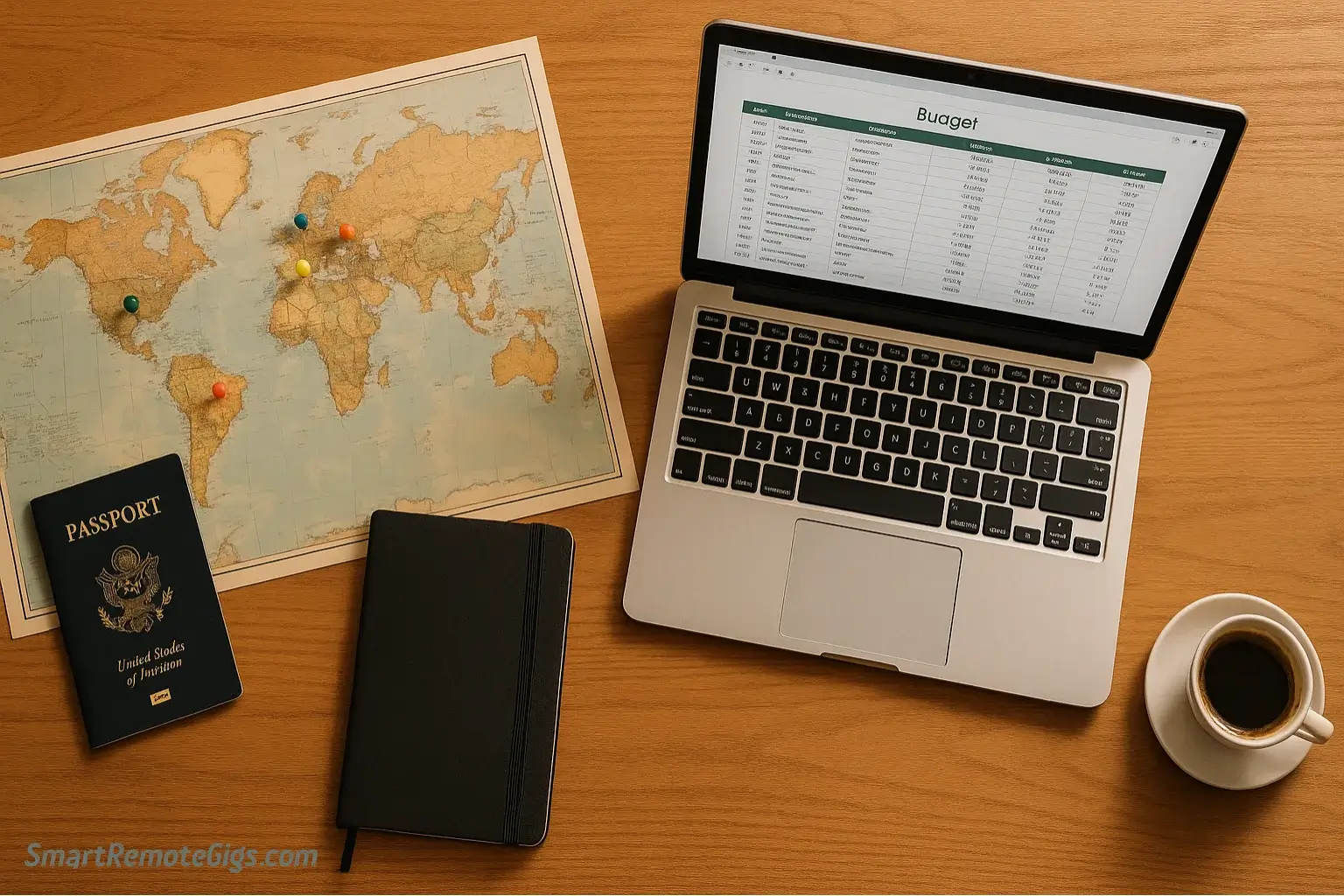
Create a strategic plan. Secure your income stream, calculate your “freedom number” (financial runway), and navigate the legal trinity of visas, taxes, and insurance.
Phase 3: The Launch Sequence – Your First 90 Days
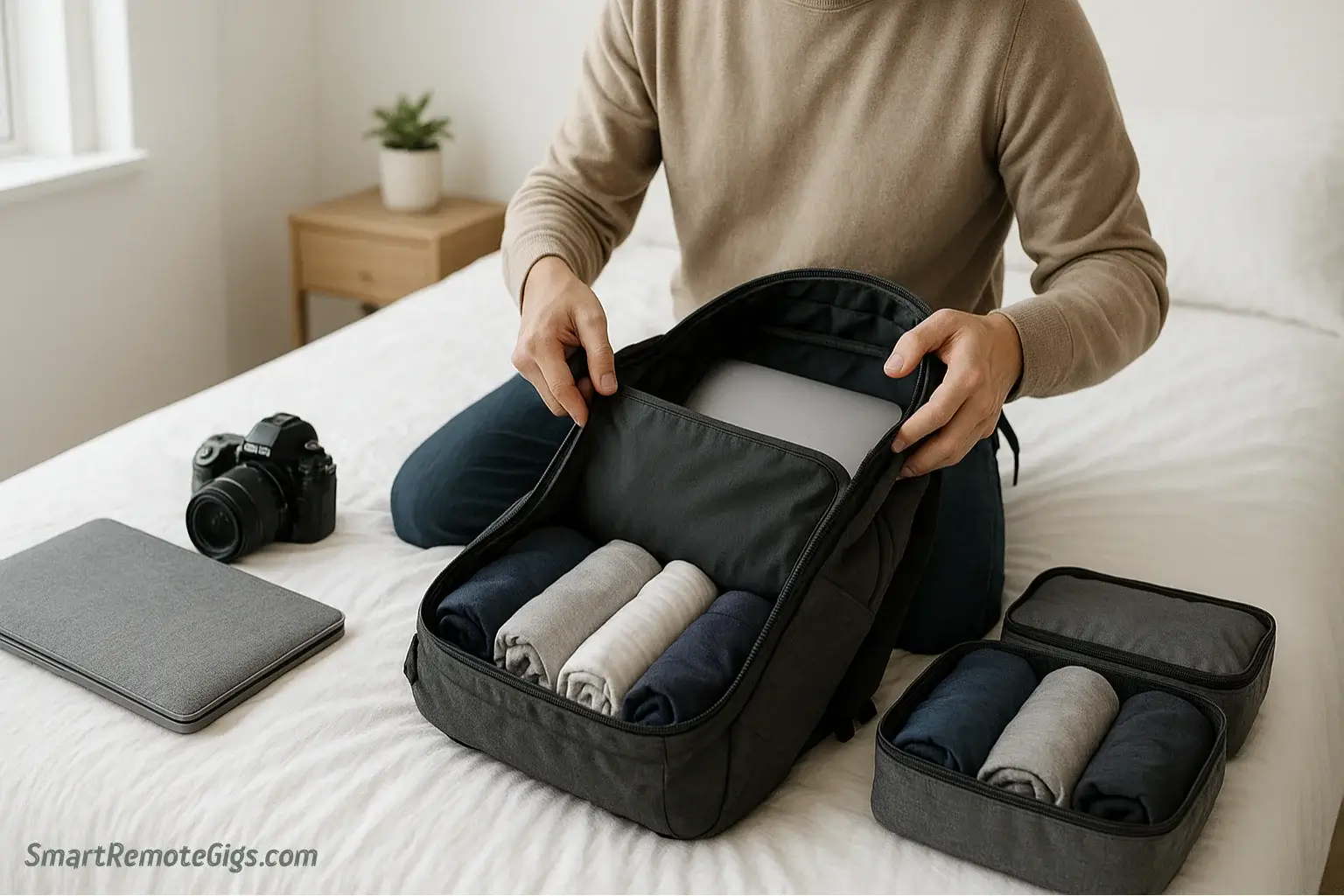
Prepare for a successful launch. Choose your first destination using a data-driven approach, downsize your life with a practical checklist, and pack the ultimate nomad gear.
Phase 4: Thriving on the Road – Beyond Survival

Build sustainable systems for long-term success. Implement productivity routines to avoid burnout, use a proven formula to build community and beat loneliness, and assemble your essential digital nomad toolkit.
Tools:
- A reliable income stream (remote job, freelancing, or business)
- A financial runway (6-month emergency fund + startup fund)
- The necessary legal documents (visas, health insurance)
- A digital nomad toolkit (tech gear, productivity apps)



